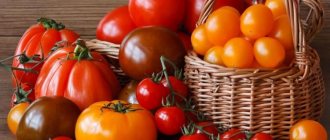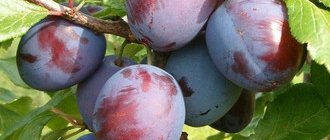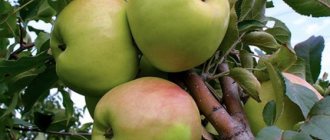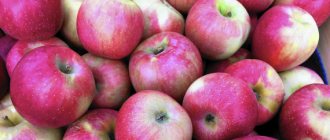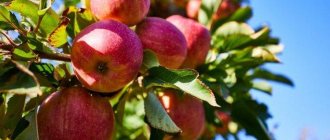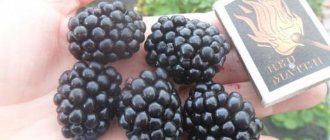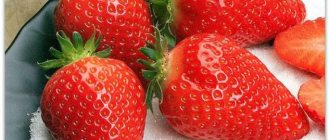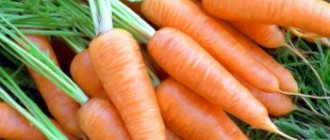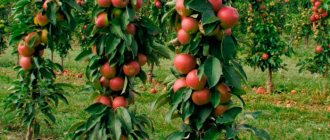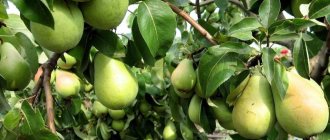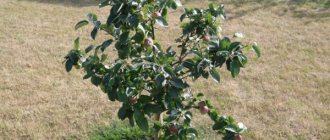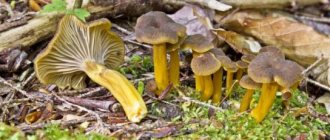The wide variety of apple varieties means that when purchasing, the gardener does not know which option to choose for growing. There are varieties of fruit trees that tolerate the climate of the Moscow region well: descriptions of the species will help gardeners find the desired option.
The climate of the Moscow region is characterized by an average annual temperature of +3.7 degrees: maximum values reach +30, and minimum values reach -12 degrees. The best varieties of apple trees for the Moscow region with a description will help you choose the type of tree with the required characteristics. New breeding varieties and old time-tested ones take root well in this region.
The most popular varieties for the Moscow region
There are ancient apple trees that remain relevant in modern gardening. Their reliability in the Moscow region has been proven by many years of practice. Unique advantages compensate for the disadvantages that are inherent in old varieties of apple trees.
Grushovka Moskovskaya
The ancient folk variety is susceptible to scab and is prone to shedding of ripening fruits. However, Grushovka attracts with its early ripening of apples (early August) and excellent frost resistance of the trees. The crown is quite high and spreading. Striped apples weigh on average 90 g. The pulp is sour-sweet, tender, loose. Harvests are plentiful, but not annual.
Melba
This “Canadian” is over a hundred years old, but it still remains a standard of taste. The pulp is balanced in density/juiciness and acidity/sweetness. The aroma is unique, candy-spicy. Apple size 100-300 g; the surface is covered with an attractive striped blush. The harvest ripens in early autumn and is stored for up to two months.
In the conditions of the Moscow region, winter hardiness is problematic: it is advisable to grow Melba in a semi-silly or bushy form. There are other disadvantages: fruit shedding, frequency of fruiting, susceptibility to scab. The variety remains in demand due to the high quality of apples and early fruiting.
Autumn striped (Streifling)
The homeland of this old variety is Holland or Germany. He came to Russia through the Baltic states; zoned since 1947 in many regions.
Main advantages:
- high productivity (up to 50-80 buckets from an adult tree);
- successful restoration of the crown after winter freezing;
- longevity of plants (45-80 years);
- harmonious taste of sweet and sour apples, wine-candy aftertaste;
- the fruits are quite large (100-200 g, up to 300 g), with an elegant streaked blush.
Scab resistance is above average. Trees begin to bear fruit at the age of 5-9 and increase their yield gradually. In the Moscow region, apples are harvested in September. They can stay in the refrigerator for 2 months, but they will become loose and bland.
INTERESTING! The crown is powerful (up to 8 m). Trees grafted onto a semi-dwarf rootstock grow shorter, but in the middle zone there is a risk of roots freezing or graft rejection.
Welsey
This “long-liver” was bred in North America more than a century and a half ago. It has been known in the Moscow region since the end of the 19th century. The fruits ripen in the fall and remain until January - February. They are juicy, crispy, with a good sweet and sour taste and a subtle spicy aroma. Apple size 95-155 g; The color is yellowish with a blurred cherry blush.
The trees are not too tall, early-fruiting, and productive (the record is 50 buckets from one tree). The variety is partially self-fertile and scab-resistant. In the Moscow region, Welsey's frost resistance is average.
Apple tree rating
This collection contains ratings of the best varieties in a certain category. They differ in taste, ripening time, properties and fruiting.
According to ripening time
There are three main groups of apples, which differ in terms of ripening:
- Summer, they ripen early and are practically not stored. These include: Yablochny Spas, Chudnoe, Arkadik, Orlinka, Melba and Grushovka Moskovskaya.
- Autumn ones that can last for several months without losing quality. These are Solnyshko, Marat Busurin, Slavyanin, Shtrifel and Zhigulevskoe.
- Winter varieties with fruits that can last a long time and even until spring. Among the best of them: Aphrodite, Flagman, Pepin saffron, Bolotovskoe, Welsey.
Among such a variety, each gardener will choose those varieties that suit his taste.
Self-pollinating
The varieties Melba, Arkadik, Welsey, Pepin saffron and Bessemyanka Michurinskaya are considered self-fertile. They form fruits without the participation of pollinators. But if an apple tree blooms nearby at the same time, then the number of fruits will be greater.
Self-pollinating Melba apple tree.
By sweetness
Of course, there are no comrades according to taste and color, and each gardener has his own preferences. But the sweetest varieties are Medunitsa and Arkadik.
According to scab resistance
Recently, breeders have been developing varieties with an acquired scab resistance gene. The most immune are considered to be Flagman, Chudnoe, Marat Busurin, Orlinka, Aphrodite, Slavyanin, Arkadik.
New
Of the latest varieties bred and registered, the most popular for cultivation in the Moscow region are Arkadik, Marat Busurin and Podarok Grafsky.
Summer apple trees
The fruits of summer varieties ripen in July or August. They are consumed fresh or processed; are not stored for a long time.
Expert opinion
Stanislav Pavlovich
Gardener with 17 years of experience and our expert
Ask a Question
IMPORTANT! The concepts should not be confused: early-ripening apple trees begin to bear fruit at a young age (from 3-4 years), and the term “early ripening (early) varieties” refers to the summer ripening period.
Elena
This new Belarusian variety has been recorded in the State Register of Russia since 2007. The ripening period is early summer (the last days of July). The trees are short, relatively winter-hardy, early-fruiting, and not hardy enough to scab. The apples are blush-pink, flat-round, tender, moderately aromatic, sour-sweet (tasting score 4.8 points). Size 85-155 g. Overripe fruits may fall off.
Apple saved
Modern Oryol selection (in the State Register since 2009). Golden fruits with raspberry stripes ripen in mid-August and weigh 190-225 g. The pulp is juicy, not too dense, sweet and sour with a slight aroma (4.3 points). Tall trees winter normally in the Moscow region and are not damaged by scab.
Orlovim
The late-summer variety was included in the State Register in 1999. It is resistant to scab. The average weight of an apple is 140 g. The surface is covered with a beautiful dark pink blush. The pulp is not loose, juicy, fragrant, sweet and sour, rich (4.5 points). The trees are medium-sized, winter-hardy, high-yielding.
Examples of varieties
What else will help you solve the problems of small areas and increase the number of varieties grown? And get faster harvests of early apples by planting and growing? Plant the following best varieties of summer apple trees.
Columnar
- Honey – with a characteristic yellowish color and honey taste. Weight ranges from 100 to 250 grams.
- The president. Bigger. Sweet and sour.
Columnar apple tree variety Medoc.
Dwarf and short
- Melba;
- Candy;
- Wonderful;
- Folk.
For northern regions
Varieties proven over the years:
- Korobovka;
- Candy;
- Melba;
- Padding;
- Suislepskoe;
- Grushovka Moscow;
- July Chernenko;
- Lungwort.
New summer
- Apple saved;
- Arkadik;
- Orlovim;
- Jubilee;
- Orlinka;
- KV-17;
- Dialogue.
Columnar apple tree KV-17.
Autumn varieties
Among the apple trees zoned in the Moscow region, there are many varieties that ripen in September - October. Those that are stored for no more than two months (until winter) are considered autumn.
Wagner's daughter
Moscow selection (in the State Register since 2002). The frost-resistant crown grows slowly, gradually reaching an average height. Juicy apples ripen in early autumn, filling up to 140-160 g. They are spherical, with a red blush. The taste is sweet and sour, with a moderate aroma (4.5 points).
Autumn Susova (Harvest Susova)
The early autumn apple tree was bred in the Moscow region and included in the State Register in 2001. The size of the apples is 95-105. They are oblong, yellow with red streaks; stored for 4 weeks. The pulp is juicy, dense, dessert-like (4.5 points). Fruiting is regular and abundant. Medium-sized, winter-hardy trees exhibit relative resistance to scab.
Young naturalist
Tambov selection. The variety has been zoned in the Central region since 1993. The crown is winter-hardy, dense, and of moderate height. Scab resistance is good. The apples are beautiful (ruddy pink) and tasty (4.5 points); size 90-130 g. In the Moscow region, fruits are harvested in mid-September; their taste improves after two weeks of storage. Apples can last 8-12 weeks. The disadvantage of the variety is some periodicity of fruiting.
See also How to properly form apple trees from planting to fruiting
Varieties of columnar apple trees
Columnar apple trees are a distinct topic that interests all gardeners and gardeners.
They are quite attractive in appearance, do not require special care, and are compact, which will allow you to plant a larger number of varieties on the site.
These varieties, among other advantages, are immune to scab:
- Malyukha. A late summer variety that bears fruit abundantly. The fruits are large, juicy, green with a slight orange-red blush. ;
- Valyukha. A late-autumn variety of beautiful and tasty apples that are stored until the New Year;
- Moscow necklace. A winter variety with medium-sized fruits and an amazing, sweet and sour taste that develops with time of storage.
Columnar apple tree Malyukha.
Winter apples for the Moscow region
Winter varieties of apple trees are those intended for consumption in winter and spring. In the Moscow region, fruits are harvested from late September to October.
According to storage periods, late apples are:
- early winter (stay for 2-3 months);
- winter (last until early March);
- late winter (stay until April - June).
The varieties with maximum shelf life (late winter) are especially valued. They have a long consumption period - from the beginning of winter to the end of spring.
Alesya
Late winter. Developed in Belarus and entered into the Russian State Register in 2002. Apples are removed from the tree as late as possible. Storage is possible until May; consumer ripeness occurs in December. The fruits are large (more than 140 g), bright purple-burgundy. The taste is sometimes described as "sourish" or "rustic", but overall good (4.3 points). The trees are low, consistently productive, and resistant to powdery mildew and scab.
Moscow winter
A hybrid of Antonovka and Welsey was obtained in the Moscow region and zoned since 2002. Late winter, resistant to frost and scab. The crown is thick, spreading, and quite high. Ruddy apples weigh more than 200 g. The pulp is medium-dense, juicy, sweet and sour, with a spicy aroma (4.3 points). The fruits are harvested in early October and last until April.
Expert opinion
Stanislav Pavlovich
Gardener with 17 years of experience and our expert
Ask a Question
IMPORTANT! Moscow winter apples contain a lot of vitamin C.
Verbnoe
This late-winter Belarusian apple tree has been on the State Register since 2009. The trees are frost-resistant and of moderate height. Immediately after picking, the fruits are practically inedible; the taste improves during storage. The harvest does not spoil until April - May. According to gardeners, Verbnoye remains juicy longer than other varieties. The skin is green with a blurred brownish-pink blush. The size of the apples is 210-245 g. The taste is sweet and sour, with a light aroma (4 points).
Varieties of dwarf apple trees for the Moscow region with photos and descriptions
Dwarf apple tree varieties are considered to be those that grow no more than two meters. They can be natural or grafted onto a dwarf rootstock. They have a number of advantages and some disadvantages.
Chudnoye is considered a low natural dwarf. Semi-dwarfs include Solnyshko, Uslada, Arkadik, Marat Busurin. But Zhigulevskoe and Melba can be grafted onto a dwarf rootstock.
Sweet varieties
Some may find sweet-fruited apple varieties a little bland due to the lack of bright sourness. They are worth planting for those with a “sweet tooth”, as well as for people with high acidity of gastric juice.
Kovalenkovskoe
The harvest ripens over time in the third ten days of August. The weight of the fruits is 145-215 g. They are raspberry-burgundy, round with a slight narrowing at the top. The juicy pulp exudes a delicate aroma. Medium-sized, winter-hardy trees do not suffer from scab. The variety comes from Belarus; since 2006 it has been zoned in the Moscow region.
INTERESTING! After a short storage, the apples become more tasty.
Delight
Breeders from the Moscow region bred this apple tree more than half a century ago; It was included in the Register of Breeding Achievements in 1996. Early autumn, with low susceptibility to scab. The first flowering occurs at the age of 5-6 years. Every year, elegant red fruits are produced that weigh 115-175 g. The small but dense crown requires periodic thinning, otherwise the fruits become smaller. Winter hardiness is good.
INTERESTING! The flesh of Uslada is tender, with reddish veins and the aroma of raspberries. It contains a high content of vitamins.
Belarusian sweet
This apple tree has been on the State Register of Russia since 2006. The harvest is harvested in the fall and stored until the New Year holidays. The size of the apples is 130-210 g. The skin is covered with a blurred dark crimson blush. The pulp is juicy, slightly aromatic (4.6 points). Medium-sized, drooping trees freeze a little in cold winters. An important advantage of the variety is genetic immunity to scab.
Autumn varieties of apple trees near Moscow
Many gardeners select several good autumn varieties for planting in the Moscow region. Fruits ripen in autumn and have a long shelf life without loss of appearance and taste.
Striefel
Strifel or Autumn Striped is a variety whose creation history is not reliably known. Presumably the apple tree came from Germany or Holland via the Baltic states.
The plant is powerful, tall, reaching up to 7-8 meters in height. The crown is wide-spreading, dome-shaped. The leaves are round and dark green in color. The fruits are medium in size, one fruit weighs 80-110 g. Apples are predominantly round in shape, sometimes one-sided specimens are found. The peel is smooth, durable, greenish-yellow or yellow in color with a characteristic blush of vertical red stripes. The pulp is yellowish, juicy, sweetish-sour.
The plant begins to bear fruit 7-8 years after planting. The plant reaches its maximum yield only at 15-18 years of age.
Bessemyanka Michurinskaya
The variety was bred by the famous breeder I.V. Michurin, which is how the name was obtained. When crossing, two varieties were used - Skryzhapel and Bessemyanka Komsinskaya.
The tree is tall, strong, and has a powerful rounded crown. The plant is characterized by wrinkled, large leaves with an emerald tint. The fruits are large, weigh about 175 g, and are predominantly round in shape and lightly ribbed. The peel is yellow with a slight shade of green, there is a crimson blush. The pulp is soft, tender, juicy. A slight wine taste is noticeable.
This is a high-yielding variety that begins to bear fruit 5-6 years after planting the seedling in the ground. Harvesting can begin from mid-September. About 220 kg of fruits are collected from one plant. On average, from the date of picking, apples are stored for 3-3.5 months.
Oryol striped
The variety was bred at VNIISPK by two famous scientific breeders in 1957. T. A., Trofimova and E. N. Sedov worked on the crossing, crossing the Bessemyanka Michurinskaya and Mackintosh apple trees.
The tree is medium-sized and has an extensive, round crown. Plants are frost-resistant and produce good yields. The leaves are round, large, green in color. The fruits are large, one fruit weighs 120-150 g, sometimes reaching 220 g. The shape of the apples is oblong, wide-conical. The main color of the peel is greenish-yellow. When fully ripe, the fruits acquire a yellow tint.
Fruiting occurs 4 years after planting. Trees 8 years old produce from 40 to 50 kg of fruit, fifteen-year-old trees can produce up to 80 kg of fruit. The harvest begins in early September. Apples can be stored in a cold room for 4 months.
Sun
To obtain the Solnyshko variety, breeders used seeds from open-pollinated crops from the early 1980s. The first fruits appeared in 1990. Apple tree breeding was carried out by E.N. Serov, V.V. Zhdanov, Z.M. Serova, E.A. Dolmatov.
The plant is low, characterized by a rounded crown. The trunks and main branches are covered with smooth red-brown bark. The leaves are ovoid, small, dark green in color. The fruits are medium-sized, weigh up to 140 g, have an oblong, slightly oblique shape, and are broadly ribbed. When removed from the tree, the peel has a yellow-green hue, then becomes light yellow with a crimson blush. The pulp is juicy.
Harvesting takes place in the fall, when the fruits are fully ripe. This period occurs in September-October - the fruits become blush.
Antonovka vulgare
There is no information about how this variety appeared. Some scientists are convinced that Antonovka became an accidental hybrid of a cultivated variety that appeared naturally from a wild forest apple tree. But most breeders are sure of one thing - the apple tree appeared in the Tula or Kursk region. N.I. Krasnoglazov first described the Antonovka variety in detail in 1848.
The tree is characterized by an oval crown shape; as the plant matures, it becomes spherical. Young branches and shoots have a brown tint. Elongated, bright green leaves adorn the plant. The apples are medium-sized, weighing up to 160 g. Their peel during the period of fruit harvesting has a green-yellow tint. During storage, the fruits turn yellow. The pulp is light, sweetish, with a very noticeable sourness.
The tree begins to bear fruit 7-8 years after planting. Full ripening of apples begins in late September or early October. As the plant grows, the yield increases. At the age of 20 years, one tree can produce up to 200 kg of fruit. Fruit storage is long - 3-4 months.
Pepin saffron
This variety was bred at the beginning of the 20th century by the famous breeder I.V. Michurin. The selection used the Renet Orleans variety and a hybrid of Chinese and Lithuanian pepinka.
The tree is medium-sized, reaching a height of three meters. The crown is round in shape. The leaves are small and green in color. The fruits are medium or small, average weight up to 140 g. The peel is dense, smooth. Apples are round-conical or cylindrical in shape. The peel is yellow-green with a dark red blush. Subcutaneous points are present. The pulp is dense, aromatic, cream-colored. Apples are sweet and sour, aromatic.
The plant begins to bear fruit in the third year after planting. Dwarf trees begin to bear fruit in the second year. The harvest is good - up to 280 kg of apples can be collected from one tree. The fruits are stored for a long time; the taste and external qualities do not deteriorate during transportation.
Zhigulevskoe
The variety was developed by breeder S.P. Kedrin. The scientist crossed the American variety Wagner with the Borovinka variety of apple tree, resulting in a new autumn variety that has become popular in Russia.
The tree predominates with a wide pyramidal or high, rounded crown, which takes on this shape during the fruiting period. The plant is medium-sized, does not exceed 4-5 m in height. The trunks and shoots are dark brown. The foliage is dense, the leaf blade is dark green in color. The leaves are characterized by an oblong, ovoid shape and large size. The apples are heavy, the weight of one fruit varies between 120-200 g. The shape of the fruit is round, sometimes wide-ribbed. The light yellow peel is dense and oily, there are subcutaneous gray dots. The creamy, coarse-grained pulp has a sweet and sour taste.
This is a fast-growing, high-yielding variety that begins to bear fruit 4-5 years after planting the tree. Apple picking begins in early September. On average, one adult plant produces up to 240 kg of fruit.
Slav
When breeding the autumn variety Slavyanin, we used the Antonovka red-barrel apple tree and variety SR 0523. The breeder E.N. Sedov was involved in the crossing.
The tree is medium-sized, grows quickly, having a rounded crown. The fruits are large, weighing up to 160 g. The apples have a flattened, conical shape. The peel is shiny, greenish-yellow in color. The flesh is cream-colored, medium flat, juicy and tender. The taste is sweet and sour, the aroma is weak.
3-4 years after planting, the tree begins to bear fruit. From one plant it is possible to obtain up to 200 kg of juicy fruits.
Marat Busurin
This is a new variety included in the State Register of Breeding Achievements in 2001. Created in 1998 by breeder V.V. Kichina, who crossed the well-known variety Autumn Joy and the donor sample SR0523.
The tree is characterized by a neat, rounded crown, dark gray bark of shoots, curved leaves of light green color with a slight shade of yellow. The fruits are large, weigh 175-200 g. The apples are round in shape and slightly flattened. The peel is smooth, green-yellow in color with fuzzy red stripes. They reach consumer maturity when the skin becomes almost white.
The variety begins to bear fruit 3-4 years after planting the seedling. The advantages of Marat Busurin include abundant and regular fruiting. The apple tree does not need annual breaks from fruit set. The average yield is 100-120 kg per adult plant.
Among the large number of apple varieties, gardeners can choose those varieties that best match the desired characteristics. Many summer, autumn and winter varieties have been bred for cultivation in the Moscow region, offering good yields.
0
0
Copy link
Self-pollinating
Apple trees set fruit by mutual cross-pollination of different varieties. But there are self-fertile forms that are prone to partial self-pollination. In this case, even a lonely tree will bear a harvest. Self-pollinating varieties of apple trees successfully form fruits in bad weather when pollinating insects do not fly.
Arkadik
Obtained in the Moscow region and patented in 2005. Winterizes well and does not suffer from scab. Active growth of the crown becomes restrained from 3-4 years, when the ovaries appear. Every year, producing abundant harvests, the trees need increased nutrition. The weight of apples is 125-345 g. They are oblong, whitish with dark pink streaks. The pulp contains a lot of aromatic, sweet juice.
Bryanskoe
Winter variety, medium-sized. Recorded in the Register of Breeding Achievements in 2001. The first flowering occurs at an early age (from 3 years). Abundant harvests are observed every year. The fruits do not spoil until the end of February. They are purple-raspberry, not hard, with a dessert taste (4.8 points) and a pleasant aroma. The weight of juicy apples is 160-295 g. Plants have genetic immunity to scab, but they are susceptible to fruit rot (moniliosis).
Pepin Saffron
The author of the variety is I.V. Michurin (recorded in the State Register since 1947). The trees are slightly drooping, not very tall, but dense (thinning is necessary). They are prone to freezing, but recover well. Late flowering avoids return frosts. High productivity is noted annually (from 5 or 6 years of age). The variety is early winter (stays until February). Striped apples weigh 80-130 g and have a characteristic spherical-conical shape.
Expert opinion
Stanislav Pavlovich
Gardener with 17 years of experience and our expert
Ask a Question
INTERESTING! The fruits of Pepin Saffron have a unique spicy aroma and wine aftertaste.
general characteristics
The early ripening subspecies is also called summer, since the timing of ripening and consumption falls precisely at this time.
Among the many newly bred varieties, many gardeners are more inclined to apple trees familiar from childhood , which have been grown on our lands for many years. They taste good, and their early ripening allows them to be appreciated already in the third year after planting.
Early ripening varieties for planting in the Moscow region
usually have average frost resistance, but there are also very winter-hardy ones. They will bear fruit periodically.
Susceptibility to diseases, scab in particular, is low , but there are now plenty of methods to combat fungi. It is fungicides that will protect the trunk and harvest from many pests and diseases.
The harvest volumes of early apple trees are good , this allows them to be processed and stored for the winter in the form of compotes, juices, and jams. All canned products have an excellent taste and are always popular with consumers.
Winter-hardy and scab-resistant
Experienced gardeners near Moscow appreciate the endurance of apple trees to the two most negative factors - frost and scab (a harmful fungus). Breeders from Belarus, the Moscow and Oryol regions, the Bryansk region and other regions are actively working in this direction. It was possible to obtain varieties of apple trees with a complex of valuable traits - frost-resistant and immune to scab.
See also: Fertilizing an apple tree for a better harvest: timing and rates of fertilizing
Sergiana
Early autumn, Moscow selection. It has been in the State Register since 2002. The crown height is moderate. The spherical-conical apples weigh 125-165 g. The surface is covered with a rich pink blush. The pulp is creamy yellow, balanced in the content of acids and sugars (4.7 points). Fragrant fruits are stored for 50-60 days.
Rozhdestvenskoe
The early winter variety was bred on Oryol land and since 2001 has been recommended for cultivation in Central Russia. Plants are medium-sized, with regular fruiting. Apples can be consumed immediately after picking or stored for 2-3 months. The taste is harmonious, the consistency is juicy (4.3 points). Fruit size is 180-245 g (up to 450 g). The blush is intense, raspberry pink. One of the disadvantages is the partial falling of ripening fruits.
INTERESTING! The aroma of tropical fruits emanates from the pulp.
Imant
Late winter Belarusian apples can be stored for up to 8 months. The early-fruiting variety was included in the Register of Russia in 2009. The weight of the apples is 145-265 g. They are round with a cone; the surface is purple-burgundy, with a bluish waxy coating. The pulp is creamy, without coarseness, slightly aromatic, sweet with “sourness” (4.3 points). Medium-sized plants are not damaged by black cancer.
Expert opinion
Stanislav Pavlovich
Gardener with 17 years of experience and our expert
Ask a Question
IMPORTANT! In especially harsh winters near Moscow, partial freezing of the crown is possible.
The best sweet varieties of apple trees for the Moscow region and their characteristics
- View the full image
Sweet varieties of apples
What do you need to know when choosing sweet varieties of apple trees?
Apple tree variety Korobovka
Apple tree variety Medunitsa
Apple tree variety Orlik
Apple tree variety Moscow Necklace
Among the fruits of the garden, apples are most valued.
They contain many useful vitamins and microelements. Apple fruits taste sour and sweet, which depends on the percentage of sugars and acid. With warm and sunny summers, the sugar content increases, which is why more sweet apples are grown in the south. The climatic conditions of the Moscow region make it possible to grow many different varieties of sweet apple trees. The sugar content in apples in relation to the amount of acid in them is called the sugar-acid coefficient, which should be within 35. Even in the middle zone, apple trees can be grown with a high sugar content of more than 12 percent with an amount of acid of 0.6 percent.
New
Breeding novelties are awaiting evaluation by practicing gardeners. Long-term tests will show how the interesting potential of the newest modern apple tree varieties released in the Moscow region is realized.
Bryansk aloe
It has been in the State Register since 2015. The medium-sized apple tree is resistant to frost and disease. Flat-round, purple-crimson fruits weigh 130-200 g. They ripen at the end of summer. The pulp is tender, juicy, with pinkish veins. The taste is sweet and sour (4.4-4.7 points).
Gordeevskoe
The winter Moscow variety was zoned for the Central region in 2013. Frost-resistant, scab-resistant. A mass of red apples weighing 130-200 g ripen on a medium-sized tree. The blush is more pronounced on the sunny side. The pulp is not hard, sweet and sour, with a spicy aroma; During storage, the taste becomes bland and sweet.
Vikor
Late-winter, early-fruiting Bryansk variety is valued for its long shelf life of fruits (until the end of spring). It was included in the State Register in 2010. The winter hardiness of medium-sized trees in the conditions of the Moscow region is characterized as satisfactory. The mass of apples is about 155 g. The blush is raspberry, blurry. The pulp is yellowish, dense; The taste is dominated by sweetness, a subtle strawberry aroma is felt.
Expert opinion
Stanislav Pavlovich
Gardener with 17 years of experience and our expert
Ask a Question
IMPORTANT! The Vikor apple tree is immune to powdery mildew, scab, and moniliosis (fruit rot).
Frost-resistant varieties
Frost resistance of a tree is one of the important requirements for growing, especially in unstable climates. This will greatly simplify caring for the plant.
Of those varieties that are resistant to scab and severe frosts, it is better to pay attention to:
- winter lungwort;
- Sokolovskoe;
- Snowdrop;
- Ermakovskoe mountain;
- Margo;
- Frigate;
- Fairy.
Frost-resistant apple tree variety Sokolovskoye.
Foreign varieties
Some prefer to grow varieties of domestic selection, because they have been tested on our territory and have extensive experience. However, there are no worse varieties of foreign origin, which also have an enviable immunity to scab.
It's better to pay attention to these:
- representatives of France: Ariane, Priam, Antares, Florina;
- guests from America: Freedom, Prima, Williams Pride, Surprise;
- representatives of Germany: Regina, Rene, Akhra;
- Poles: Vitos, Free Redstar;
- Swiss variety Arriva;
- Dutch Santana.
Tall
What apple trees are best to plant at a dacha in the Moscow region to get a bountiful harvest? If the size of the land plot is large enough, then you can find a place for varieties with a high crown (5-8 m).
Pepin Orlovsky (Reliable)
Zoned in the Central region in 2001. Frost-resistant, winter consumption. It is practically not affected by scab. Fruiting is regular and abundant. Wide-conical raspberry apples weigh 135-150 g. The pulp is very juicy, sweet and sour (4.3 points).
Renet Karpova
The Tambov variety for autumn consumption has been on the State Register since 2002. Fruit weight is 105-120 g. They are bright, with purple-burgundy stripes. The pulp is fragrant, medium-dense, sour-sweet (4.7 points). In cold winters there is a risk of freezing.
Columnar and dwarf varieties
Recently, dwarf and columnar varieties of apple trees have become especially popular among gardeners. They do not take up much space, are easier to care for and harvest, and bear fruit quite abundantly.
Attention! Do not confuse columnar and dwarf varieties of fruit trees. The difference between them can be seen in the crown: the columnar ones have erect branches, while the dwarf ones have a more lush and splayed branch system.
Among the early-ripening suitable for the Moscow region:
- Candy dwarf;
- Melba dwarf;
- Wonderful;
- Bratchud.
The proposed trunks not only bear fruit abundantly, but also look great against the general background of both large and small gardens.
The earliest varieties of apple trees for the Moscow region among the columnar ones:
- Chervonets;
- Raika;
- Ray;
- Ideal.
Medium height
Apple trees 3-4 meters high combine high productivity with ease of processing and shaping.
Muscovite
Included in the State Register in 2004. Ripening period is autumn, winter hardiness is good. Wide-conical, blush-pink apples weigh 115-125 g. The pulp is sweet and sour, juicy (4.5 points).
Memory of Sikora
The late-winter apple tree was obtained in Belarus and zoned in the Central region of Russia in 2002. One of the “parents” of the variety, the famous Renet Simirenko, passed on the skin color to the descendant. The apples are green, without allergenic blush. The size of the mature fruit is 95-120 g. The pulp is medium juicy, sweet and sour, with a moderate aroma. In the Moscow region, it is possible for a tree to freeze in the cold winter.
